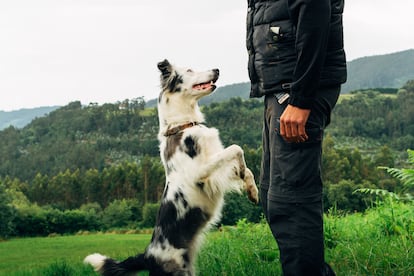Does your dog need a trainer? Signs to look for and how to choose one
Is your pet causing problems at home? To find a solution, it is important to know the difference between unwanted conducts and actual behavior problems

If you just got a new dog, you may have countless questions; more so if it is your first time sharing the house with a four-legged companion. These animals have their own particular needs, as well as a completely different language, and this can sometimes cause confusion and disagreements. But when do those inconveniences become a problem that requires a trainer?
First of all, let’s be clear: educating and training are not the same thing. “Educating a dog implies developing its emotional, cognitive and social capacities, so that it acquires skills that help it live harmoniously in our cities. Therefore, education and coexistence go hand in hand,” explains Óscar Páez Sousa, president of the National Association of Professional Dog Trainers (ANACP), in Spain. An example of this would be the dog learning not to jump on people in the street or how to interact correctly with other dogs. “Training consists of teaching it to carry out certain behaviors under the control of a discriminative stimulus, such as a command or an order,” says Páez Sousa. This is where classic commands like “sit” and “stay” come in.
This leads to a second clarification: it is important to differentiate between unwanted behaviors and behavior problems. “An unwanted behavior is when the dog behaves in a way that is not acceptable to the owner, but which doesn’t imply suffering or stress and doesn’t compromise the animal’s health,” continues Páez Sousa. Any dog owner can mention examples of this: barking, stealing food, requests for constant attention or urinating and defecating inside the house when they are no longer puppies. These conducts are easier to correct than behavioral problems which, as Páez Sousa points out, “do affect animal wellbeing and entail a decline in the dog’s physical and psychological health.” We are talking about separation anxiety or problems with fears, phobias or aggressiveness.
When is it necessary to see a trainer?
You must see a professional when these behavior problems occur, but it’s best to anticipate them. “When behavior problems arise, they are generally situations that could have been prevented by using the right tools in time,” says Sara Casado, a specialist in canine education and behavior modification at the ACEO training center in Madrid, Spain. “When we think of a trainer, what comes to mind is teaching our dog commands, getting them to obey. But in most cases in which the dog ignores its owner, what they need is to improve their bond, to learn the signals that the animal gives and to know why it does what it does. When we improve these three aspects, obedience as such is relegated to the background,” points out Casado. “When we talk about an obedient dog, what we really mean is a balanced dog that understands us and vice versa.”
The problems begin when the dog starts to become destabilized. Nacho Sierra, a canine trainer and animal behavior specialist, is categorical: help is needed “when behaviors that the owner fails to understand or control are first detected.” This is the best way to prevent something that can be solved in a few sessions from becoming a more serious problem for the dog and its human family.

How long does the training last? Should the family participate?
How long training lasts depends on the severity of the problem. “Depending on the case, it can take from six or eight weeks, which is the most common length, to six months or, in difficult cases, a year,” Casado explains. However, it is important to bear in mind that the guidelines learned during training are applicable for life and must be incorporated permanently into the family routine.
One of the determining circumstances of the training is the pet’s age. “With puppies, you have to focus much more on the initial challenges such as socialization, learning hygiene guidelines and, ultimately, getting to know the place in which they are going to be living. Also, their exercises must be adapted to the level of difficulty they can face at that age,” says trainer Javier Martínez Torres, head of the Solo Es Un Perro training center in Madrid. Then there are the young dogs, those that have already reached their morphological growth (approximately eight months) but have not yet reached maturity (up to 18-24 months). They are much more emotionally sensitive and need to have positive experiences, aside from learning the communication skills of older dogs.

Finally, adults can also be trained, but they require much more patience and persistency. “Adult dogs, from experience, tend to have consolidated certain learning and unwanted behaviors that have been inadvertently reinforced by the owner and that are usually resistant to change,” explains Páez Sousa.
In any case, regardless of the pet’s age, the experts agree that it is essential that the animal’s family be involved in its training. This will likely mean investing time and effort in something that usually becomes a daily endeavor.
How to choose the right trainer?
First of all, it is important to find a certified trainer. Other aspects to look for are their demonstrable professional experience and that they employ training methods that are respectful of the animal’s wellbeing. Also, be wary of those who offer quick results or do not provide resources and tools so that the animal’s education can continue. Additionally, Casado mentions it is important to ensure they are aware of the latest research on training. “Scientific research on the canine learning process and training methodologies have evolved a lot in the last 15 years, which makes many traditional methodologies obsolete today.”
Sign up for our weekly newsletter to get more English-language news coverage from EL PAÍS USA Edition
Tu suscripción se está usando en otro dispositivo
¿Quieres añadir otro usuario a tu suscripción?
Si continúas leyendo en este dispositivo, no se podrá leer en el otro.
FlechaTu suscripción se está usando en otro dispositivo y solo puedes acceder a EL PAÍS desde un dispositivo a la vez.
Si quieres compartir tu cuenta, cambia tu suscripción a la modalidad Premium, así podrás añadir otro usuario. Cada uno accederá con su propia cuenta de email, lo que os permitirá personalizar vuestra experiencia en EL PAÍS.
¿Tienes una suscripción de empresa? Accede aquí para contratar más cuentas.
En el caso de no saber quién está usando tu cuenta, te recomendamos cambiar tu contraseña aquí.
Si decides continuar compartiendo tu cuenta, este mensaje se mostrará en tu dispositivo y en el de la otra persona que está usando tu cuenta de forma indefinida, afectando a tu experiencia de lectura. Puedes consultar aquí los términos y condiciones de la suscripción digital.
More information
Últimas noticias
Russell Tovey: ‘I was advised many times not to come out, I don’t think there was many people who’d done that — and I feel really proud that I’m one of those that did’
Patagonia’s puma population soars thanks to unexpected prey: penguins
Merz tries to replace Macron at the helm of Europe
Indulgence, punishment and family dynamics: Maintaining a healthy relationship with food during the holiday season
Most viewed
- The low-cost creative revolution: How technology is making art accessible to everyone
- Families demand repatriation of bodies of Colombians who died in Ukraine: ‘This war is a slaughterhouse for foreigners’
- Christian Louboutin: ‘Young people don’t want to be like their parents. And if their parents wear sneakers, they’re going to look for something else’
- US sanctions against jailed cartel leader ‘El Marro’ highlight Mexico’s lack of control over its prisons
- Liset Menéndez de la Prida, neuroscientist: ‘It’s not normal to constantly seek pleasure; it’s important to be bored, to be calm’











































